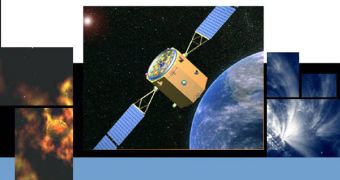The official Chinese news agency Xinhua reported yesterday that the country had postponed the launch of its first space telescope by two years, until 2012, due to cost problems. The Hard X-ray Modulation Telescope (HXMT) will be the country's first observatory, originally scheduled for launch in 2010, as part of the nation's ambitious space program, which already saw the launch of the first “taikonauts” in low-Earth orbit in 2003. The cost of the observatory is estimated to be of about one billion yuan ($146.4 million), which is not much by NASA standards, for example.
The instrument is the first of its kind, designed specifically for discovering and analyzing black holes. Rather than sporting a set of lenses or mirrors to aid it in observing the Universe, the HXMT will use three or four single telescopes, each of them outfitted with hard X-ray detectors. It is essentially based on the direct demodulation (DD) method and the well-developed NaI(Ti)/CsI(Na) phoswich detecting techniques. NaI(Ti) stand for sodium iodide doped with thalium. The collimated hard X-ray instrument will work with particles in the 20-to-200-keV energy range.
It will scan the skies looking for X-ray sources, and the team behind the project, supported by the Ministry of Science and Technology of China, the Chinese Academy of Sciences, and the leading Tsinghua University, believes that more than 1,000 of them will be discovered in the four years the HXMT is scheduled to remain in operation. The basic targets of the planned telescope are:
An all-sky, hard X-ray survey. To draw a high-precision, hard X-ray sky map and to discover about 1,000 new, hard X-ray sources including possible new types of objects;
X-ray binaries. An X-ray binary involves a compact object (a black hole or a neutron star) and a normal star. HXMT will observe the hard X-ray spectra and temporal variability of X-ray binaries, study the formation and evolution of accretion disks, jets and black holes, and further test various general relativistic effects;
Soft Gamma-ray burst Repeaters (SGRs). SGRs are thought to be high-energy, transient sources associated with young highly magnetized neutron stars;
Gamma-ray bursts (GRBs). GRBs are the most violent explosions is the universe. Their origin is a serious challenge to astrophysics;
Clusters of galaxies – the largest systems that are bound gravitationally in the universe. HXMT will study the hard X-ray emission of clusters of galaxies and explore their origin.
Expectations are high off the new instrument, which will undoubtedly be closely followed by other space agencies as well. The new type of technology that is being used could finally shed some more light on some of the mysteries surrounding black holes, as well as some of the most elusive phenomena in our Universe.

 14 DAY TRIAL //
14 DAY TRIAL //